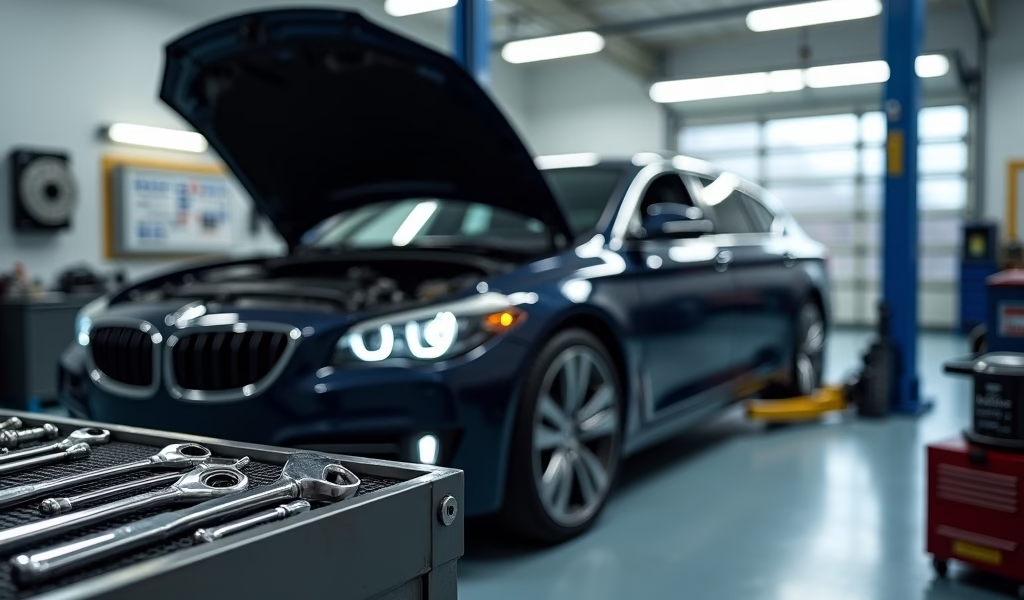Overview
Regular auto tune-up service involves five essential maintenance procedures: oil changes, air filter replacement, spark plug inspection, fuel system cleaning, and battery testing—all crucial for extending vehicle life and preventing costly repairs. These preventative measures improve fuel economy, ensure reliable performance, and can save thousands in repair costs compared to the relatively modest $200-400 investment in regular maintenance.
Table of Contents
- Introduction
- Oil Change and Filter Replacement
- Air Filter Maintenance
- Spark Plug Inspection and Replacement
- Fuel System Cleaning
- Battery Testing and Maintenance
- Conclusion
- Frequently Asked Questions
Understanding the Importance of Auto Tune Up Service
Your vehicle is a complex machine that requires regular care to perform at its best. As a mechanic with over 20 years of experience, I’ve seen firsthand how a proper auto tune up service can breathe new life into aging vehicles and prevent costly repairs down the road.
Think of a tune-up as preventative medicine for your car. Just like you need regular check-ups to stay healthy, your vehicle needs periodic maintenance to keep running smoothly. Most drivers only bring their cars in when something’s already wrong—I’m here to tell you why that approach costs you more in the long run.
Modern vehicles are engineering marvels with computerized systems that need proper care. A comprehensive auto tune up service addresses several vital components simultaneously, ensuring they work together harmoniously to extend your vehicle’s lifespan and optimize performance.
Let’s dive into the five proven fixes that make up an effective tune-up—maintenance steps that will transform your vehicle’s reliability and save you money over time. I’ll walk you through each one, explaining why it matters and what happens if you neglect it.
1. Oil Change and Filter Replacement: The Lifeblood of Your Engine
If your car had a circulatory system, engine oil would be its blood. Clean oil lubricates moving parts, reduces friction, dissipates heat, and prevents harmful deposits from forming inside your engine. Without regular oil changes, those moving parts start grinding against each other, leading to accelerated wear and potentially catastrophic engine failure.
Over time, oil degrades and becomes contaminated with dirt, debris, and metal particles from normal engine wear. What starts as a smooth, amber fluid gradually turns into a thick, black sludge that can’t properly protect your engine. This transformation happens whether you drive the car or not—oil breaks down naturally over time.
Here’s how often you should change your oil based on your vehicle type:
- Newer vehicles using full synthetic oil: Every 7,500-10,000 miles
- Vehicles using conventional oil: Every 3,000-5,000 miles
- Older vehicles (pre-2000): Every 3,000 miles
- Vehicles driven in extreme conditions (excessive heat, cold, or dust): More frequently than the standard recommendation
Always check your owner’s manual for the manufacturer’s specific recommendations. These guidelines aren’t arbitrary—they’re based on extensive testing of your particular engine design.
The oil filter is equally important but often overlooked. This component traps contaminants before they can circulate through your engine and cause damage. A clogged filter forces oil to bypass the filtering element entirely, allowing dirty oil to circulate freely. Always replace the filter with every oil change—it’s inexpensive protection against costly engine repairs.
Using the right oil viscosity (thickness) matters tremendously. Your owner’s manual specifies the correct viscosity for your engine (like 5W-30 or 0W-20). Using the wrong viscosity can reduce fuel efficiency, increase engine wear, and in extreme cases, void your warranty.
During a professional auto tune up service, a technician will drain the old oil, install a new filter, and refill with the manufacturer-recommended oil. They’ll also check for leaks and inspect other fluid levels while they’re under the hood.

2. Air Filter Maintenance: Let Your Engine Breathe
Your engine needs the right mix of air and fuel to run efficiently. The air filter acts as your engine’s lungs, trapping dust, pollen, bugs, and road debris before they can enter the combustion chamber. A clean air filter ensures proper airflow, directly impacting your vehicle’s performance, fuel economy, and emissions.
When your air filter clogs with dirt and debris, your engine struggles to breathe. This restricted airflow creates an imbalanced air-fuel mixture—typically too rich—causing your engine to burn more fuel while delivering less power. It’s like trying to run a marathon while breathing through a straw.
Warning signs of a clogged air filter include:
- Decreased fuel economy (you’re filling up more often)
- Sluggish acceleration when you press the gas pedal
- Rough idling or unusual engine sounds
- Black smoke from the exhaust
- Check engine light illumination (in severe cases)
Most manufacturers recommend replacing the air filter every 15,000 to 30,000 miles, but this interval shortens if you drive in dusty environments or heavy traffic. During your regular brake service appointments, ask your mechanic to check your air filter too. Visual inspection is usually sufficient—a new filter is white or off-white, while one needing replacement appears gray, black, or visibly dirty.
The good news? Air filter replacement is one of the most cost-effective maintenance tasks. Filters typically cost $10-25, and many car owners can replace them at home with basic tools. If you’re unsure how to do it, any auto tune up service will include air filter inspection and replacement if needed.
Some newer vehicles also have cabin air filters that clean the air you breathe inside the car. These should be replaced according to your owner’s manual schedule—typically every 15,000-30,000 miles. A fresh cabin filter improves air quality and helps your HVAC system work more efficiently.
3. Spark Plug Inspection and Replacement: The Spark of Life
Spark plugs might be small, but they’re mighty! These engineering marvels create the electrical spark that ignites the air-fuel mixture in your engine’s combustion chambers. Without properly functioning spark plugs, your engine simply won’t run correctly—or at all.
Each spark plug must fire hundreds of times per minute while withstanding extreme heat and pressure. Over time, the electrodes erode and deposits build up on the firing end, increasing the voltage required to create a spark. This leads to misfires, hard starts, rough idling, and decreased fuel economy.
According to NGK Spark Plugs, one of the leading manufacturers of ignition components, you’ll notice these warning signs when spark plugs are failing:
- Engine misfires or hesitation during acceleration
- Rough idling (the engine shakes when stopped)
- Difficulty starting, especially in cold weather
- Increased fuel consumption
- Lack of acceleration when you press the gas pedal
Modern vehicles with iridium or platinum spark plugs can go 60,000 to 100,000 miles before replacement. Traditional copper plugs typically need changing every 30,000 to 50,000 miles. Your owner’s manual will specify the correct replacement interval and the exact type of spark plug required for your engine.
During a comprehensive auto tune up service, a technician will remove and inspect each spark plug, checking for proper gap and signs of engine problems. A trained eye can diagnose potential issues by examining spark plug condition—oil-fouled plugs might indicate worn valve guides, while overheating signs could point to cooling system problems.
Many drivers are amazed by the immediate improvement in how their vehicle runs after spark plug replacement. It’s like giving your car a shot of espresso—suddenly it’s more responsive, runs smoother, and uses fuel more efficiently.
While replacing spark plugs, it’s also wise to inspect the ignition coils and spark plug wires (if your vehicle has them). These components work together with the plugs and can cause similar symptoms when failing. A thorough brake shop visit should include a complete inspection of these systems.
4. Fuel System Cleaning: Clear the Arteries
Your fuel system is a complex network of components that deliver the precise amount of fuel needed for combustion. Over time, fuel injectors, intake valves, and combustion chambers accumulate deposits from fuel impurities and combustion byproducts. These deposits restrict fuel flow and impair spray patterns, much like cholesterol restricting blood flow in arteries.
Modern gasoline contains detergents designed to prevent deposit buildup, but they’re not always sufficient—especially in vehicles that make frequent short trips or idle extensively. Carbon deposits gradually form on intake valves and injector tips, disrupting the fine mist of fuel needed for efficient combustion.
The symptoms of a clogged fuel system develop gradually, which is why many drivers don’t notice until problems become severe:
- Hesitation or stumbling during acceleration
- Rough idle or stalling
- Hard starting (especially when the engine is warm)
- Decreased fuel economy
- Failed emissions tests
- Engine knocking or pinging
A professional fuel system cleaning during your auto tune up service removes these harmful deposits using specialized equipment and cleaning solutions. The process typically involves:
- Adding a cleaning solution to the fuel tank
- Connecting professional equipment to the fuel rail
- Running the engine while the cleaner circulates through the system
- In severe cases, removing and ultrasonic cleaning of injectors
Research by the Society of Automotive Engineers has shown that removing carbon deposits can restore lost power, improve fuel economy by up to 5%, and reduce harmful emissions. Most mechanics recommend a comprehensive fuel system cleaning every 30,000 miles or when you notice performance issues.
Between professional cleanings, high-quality fuel system additives can help maintain cleanliness. These products won’t remove heavy existing deposits but can prevent new ones from forming. Consider using a fuel system cleaner every 3,000-5,000 miles, especially if you frequently purchase fuel from discount stations that may contain fewer detergents.
During your next brake repair appointment, ask your technician to inspect your fuel system components. They can often spot problems before they lead to drivability issues or expensive repairs.

5. Battery Testing and Maintenance: Power When You Need It
Your vehicle’s battery does more than just start the engine. It stabilizes voltage for the entire electrical system and powers accessories when the engine isn’t running. A weak battery affects everything from your car’s computer systems to its starting ability—especially in extreme temperatures.
Battery failures rarely happen without warning. As a battery weakens, it gives several signals that experienced mechanics can detect during routine maintenance:
- Slow engine cranking during startup
- Dimming headlights, especially at idle
- Electronic systems behaving erratically
- Warning lights on the dashboard
- Swollen battery case or corrosion on terminals
During an auto tune up service, your technician should perform several battery-related checks:
- Voltage testing (a healthy battery shows 12.6V when fully charged)
- Load testing to assess the battery’s ability to deliver current
- Inspection and cleaning of terminals and cables
- Testing the charging system (alternator) output
- Checking for parasitic drains that might be depleting the battery
Most car batteries last 3-5 years, depending on climate, driving habits, and vehicle electrical demands. Heat is particularly hard on batteries—the American Automobile Association notes that batteries in hot southern climates often last only 2-3 years, while those in moderate northern climates might survive 4-5 years.
Simple battery maintenance can extend life and prevent failures. If your terminals show white or greenish corrosion, disconnect the cables (always negative first) and clean them with a wire brush and a solution of baking soda and water. Rinse with clean water and dry thoroughly before reconnecting (positive first, then negative).
For vehicles driven infrequently, consider using a battery maintainer (trickle charger) to keep the battery at full charge. These inexpensive devices prevent the gradual discharge that occurs naturally over time and can significantly extend battery life.
Conclusion: The Value of Regular Auto Tune Up Service
A comprehensive auto tune up service isn’t just a maintenance expense—it’s an investment in your vehicle’s longevity and performance. The five components we’ve covered form the foundation of preventative maintenance, catching small issues before they become major problems.
Consider the math: a complete tune-up might cost $200-400 depending on your vehicle, while an engine replacement could run $3,000-7,000. Regular maintenance is always less expensive than repair, not to mention the convenience of planned service versus unexpected breakdowns.
By staying on top of these five critical maintenance areas, you’ll enjoy:
- Improved reliability and fewer unexpected breakdowns
- Better fuel economy and lower operating costs
- Extended vehicle lifespan—potentially years longer
- Higher resale value when it’s time to sell or trade
- A smoother, more responsive driving experience
I recommend keeping a simple maintenance log in your glove compartment. Record the date, mileage, and services performed each time you have work done. This creates a history you can reference and adds value when selling your vehicle.
Remember that these maintenance items aren’t optional extras—they’re essential services that keep your vehicle running as the manufacturer intended. Just as you wouldn’t skip doctor visits to save money, don’t skip the tune-ups your car needs to stay healthy.
Your owner’s manual contains a recommended maintenance schedule specifically designed for your vehicle model. Use it as your guide, and you’ll enjoy years of trouble-free driving. Your car deserves proper care, and ultimately, so do you.
Frequently Asked Questions
How often should I get an auto tune up service?
Most vehicles benefit from a comprehensive tune-up every 30,000 miles or according to your owner’s manual maintenance schedule. More frequent tune-ups may be necessary for older vehicles or those driven in extreme conditions.
How much does a tune up cost?
A basic tune-up typically costs between $150-300, while a comprehensive service can range from $300-500 depending on your vehicle make and model. The cost varies based on parts needed and labor rates in your area.
Can I perform a tune-up myself?
Some tune-up components like air filter replacement are DIY-friendly, but others require specialized tools and diagnostic equipment. For comprehensive results, professional service is recommended, especially for newer vehicles with complex electronic systems.
How long does a tune-up take?
A basic tune-up usually takes 1-2 hours, while a comprehensive service might require 2-4 hours depending on your vehicle. Many shops offer loaner cars or shuttle services during longer maintenance appointments.
Will a tune-up improve my gas mileage?
Yes, a proper tune-up can improve fuel economy by 4-12% depending on your vehicle’s condition before service. The combination of fresh filters, clean injectors, and properly functioning ignition components allows your engine to operate at peak efficiency.


Pingback: How to Reset a Car’s Check Engine Light - knowsyourcar.com
Pingback: How to Check Car Alignment: 6 Quick Tips - knowsyourcar.com